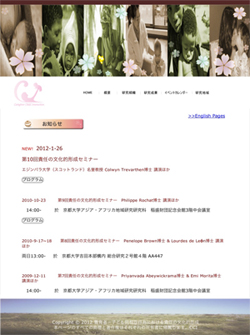要旨:第3回 国際シンポジウム Responsibility in Relationships: Linguistic Anthropological Approach(2008・10・25-26開催)
1. Alessandro Duranti (UCLA)
Language as a non-neutral medium
In an earlier article (“Language as Culture in U.S. Anthropology: Three Paradigms.” Current Anthropology, vol. 44, 2003), I argued that the diverse approaches and contributions within linguistic anthropology over the last 120 years can be organized in terms of three distinct paradigms, which developed at different times but now co-exist. In this paper, I carve a different path. I take on the challenge of conceptualizing the field of linguistic anthropology in terms of one general criterion. To do this, I review the existing literature in terms of three essential properties of language, namely: (1) language as a code for representing experience, (2) language as a form of social organization, and (3) language as a system of differentiation. I then argue that even though to each of these three properties corresponds a different ontological commitment, all of them stem from a higher-order ontological commitment to study language as a non-neutral medium.
2. Elinor Ochs (UCLA)
Responsibility in Childhood: Three Developmental Stories
This presentation analyzes the concept of responsibility through the lens of Matsigenka, Samoan, and middle-class Los Angeles childhoods. It proposes that social awareness, social responsiveness, and self-reliance are keystone properties of responsibility. It argues that children’s routine work at home promotes not only social but also moral responsibility, in the form of respectful awareness of and responsiveness to others’ needs and reliance on knowledge that takes into consideration others’ judgments. In contrast with Matsigenka and Samoan children, many L.A. children observed displayed helplessness, with parents assisting them in simple activities. The analysis proposes that such assistance creates a Dependency Dilemma. It presents seven arguments (related to Necessity, Development, School Priority, Social Organization, Independence-Interdependence, Attention, and Inconsistency) that bear on these observations. Moral responsibility is conceptualized as an active turning towards the other that begins corporeally through childhood socialization practices and moves on to embrace the capacity for compassion.
* Carolina Izquierdo (UCLA)との共同研究
3. Michie Kawashima (JSPS/Saitama Univ.)
Relating with the unseen as a family member
Having a new family member involves many changes in family relationship. Preparing for such changes is a main concern among pregnant women. Through bodily sensation, a pregnant woman can perceive movement of fetus in some way. On the other hand, other family members such as husband and older child can neither see the fetus nor feel it. With such vast discrepancy in perceiving a new member of family, some specific bodily and conversational interaction can take place in family interaction for discussing the fetus. This study examines some of the interactional forms that evoke existence of the fetus during the family interaction.
4. Yohko Shimada (Kyoto Univ.)
Resources for give-and-take activities by 7-14 month-old infants
Infants around 9 months old begin to join give-and-take activities supported by social-cognitive abilities such as joint attention. This study explores resources for give-and-take activities in natural interaction. Natural interactions between caregivers and infants in their 7-to-14 month-old were recorded once a month at their home. The infant’s actions, which occur at around taking an object, are categorized into four types (Object taking, Triangular, Giving, and Failure). Each type can be related to the infant’s postures and distributions of attention in relating with potential giver and taker.
5. Akira Takada (Kyoto Univ.)
Interactional conditions for the reciprocal give-and-take activity
Young children become increasingly active in giving things to or taking things from another. The interaction patterns are then gradually shaped, with reference to the cultural norms of a given speech community. What is emphasized less often is that young children do not always take actions in accordance with the sequential order of interactions. When the variety of operations increased, the pattern of the interaction becomes rather disarrayed. The reactions to such “infelicitous” actions are important, particularly when discussing early language socialization. Based on the data set we started collecting recently I clarify the conditions that enable the reciprocal give-and-take activity.

